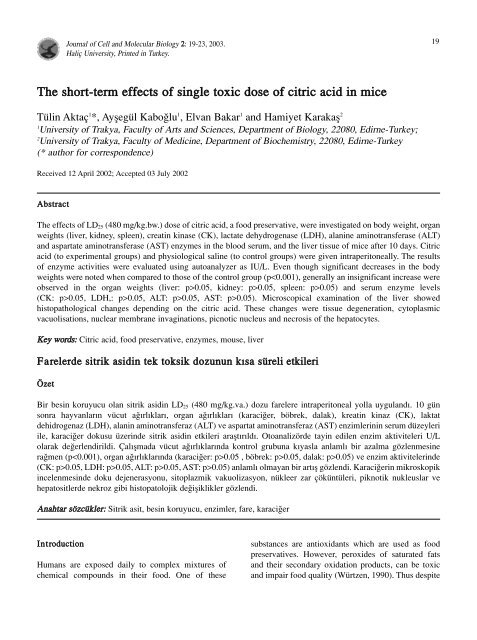(Converted)-4 - Journal of Cell and Molecular Biology - Haliç ...
(Converted)-4 - Journal of Cell and Molecular Biology - Haliç ...
(Converted)-4 - Journal of Cell and Molecular Biology - Haliç ...
You also want an ePaper? Increase the reach of your titles
YUMPU automatically turns print PDFs into web optimized ePapers that Google loves.
<strong>Journal</strong> <strong>of</strong> <strong>Cell</strong> <strong>and</strong> <strong>Molecular</strong> <strong>Biology</strong> 2: 19-23, 2003.<br />
<strong>Haliç</strong> University, Printed in Turkey.<br />
The short-term effects <strong>of</strong> single toxic dose <strong>of</strong> citric acid in mice<br />
Tülin Aktaç 1 *, Ayflegül Kabo¤lu 1 , Elvan Bakar 1 <strong>and</strong> Hamiyet Karakafl 2<br />
1University <strong>of</strong> Trakya, Faculty <strong>of</strong> Arts <strong>and</strong> Sciences, Department <strong>of</strong> <strong>Biology</strong>, 22080, Edirne-Turkey;<br />
2University <strong>of</strong> Trakya, Faculty <strong>of</strong> Medicine, Department <strong>of</strong> Biochemistry, 22080, Edirne-Turkey<br />
(* author for correspondence)<br />
Received 12 April 2002; Accepted 03 July 2002<br />
Abstract<br />
The effects <strong>of</strong> LD25 (480 mg/kg.bw.) dose <strong>of</strong> citric acid, a food preservative, were investigated on body weight, organ<br />
weights (liver, kidney, spleen), creatin kinase (CK), lactate dehydrogenase (LDH), alanine aminotransferase (ALT)<br />
<strong>and</strong> aspartate aminotransferase (AST) enzymes in the blood serum, <strong>and</strong> the liver tissue <strong>of</strong> mice after 10 days. Citric<br />
acid (to experimental groups) <strong>and</strong> physiological saline (to control groups) were given intraperitoneally. The results<br />
<strong>of</strong> enzyme activities were evaluated using autoanalyzer as IU/L. Even though significant decreases in the body<br />
weights were noted when compared to those <strong>of</strong> the control group (p0.05, kidney: p>0.05, spleen: p>0.05) <strong>and</strong> serum enzyme levels<br />
(CK: p>0.05, LDH,: p>0.05, ALT: p>0.05, AST: p>0.05). Microscopical examination <strong>of</strong> the liver showed<br />
histopathological changes depending on the citric acid. These changes were tissue degeneration, cytoplasmic<br />
vacuolisations, nuclear membrane invaginations, picnotic nucleus <strong>and</strong> necrosis <strong>of</strong> the hepatocytes.<br />
KKeeyy wwoorrddss:: Citric acid, food preservative, enzymes, mouse, liver<br />
Farelerde sitrik asidin tek toksik dozunun k›sa süreli etkileri<br />
Özet<br />
Bir besin koruyucu olan sitrik asidin LD25 (480 mg/kg.va.) dozu farelere intraperitoneal yolla uygul<strong>and</strong>›. 10 gün<br />
sonra hayvanlar›n vücut a¤›rl›klar›, organ a¤›rl›klar› (karaci¤er, böbrek, dalak), kreatin kinaz (CK), laktat<br />
dehidrogenaz (LDH), alanin aminotransferaz (ALT) ve aspartat aminotransferaz (AST) enzimlerinin serum düzeyleri<br />
ile, karaci¤er dokusu üzerinde sitrik asidin etkileri araflt›r›ld›. Otoanalizörde tayin edilen enzim aktiviteleri U/L<br />
olarak de¤erlendirildi. Çal›flmada vücut a¤›rl›klar›nda kontrol grubuna k›yasla anlaml› bir azalma gözlenmesine<br />
ra¤men (p0.05 , böbrek: p>0.05, dalak: p>0.05) ve enzim aktivitelerinde<br />
(CK: p>0.05, LDH: p>0.05, ALT: p>0.05, AST: p>0.05) anlaml› olmayan bir art›fl gözlendi. Karaci¤erin mikroskopik<br />
incelenmesinde doku dejenerasyonu, sitoplazmik vakuolizasyon, nükleer zar çöküntüleri, piknotik nukleuslar ve<br />
hepatositlerde nekroz gibi histopatolojik de¤ifliklikler gözlendi.<br />
AAnnaahhttaarr ssöözzccüükklleerr:: Sitrik asit, besin koruyucu, enzimler, fare, karaci¤er<br />
Introduction<br />
Humans are exposed daily to complex mixtures <strong>of</strong><br />
chemical compounds in their food. One <strong>of</strong> these<br />
substances are antioxidants which are used as food<br />
preservatives. However, peroxides <strong>of</strong> saturated fats<br />
<strong>and</strong> their secondary oxidation products, can be toxic<br />
<strong>and</strong> impair food quality (Würtzen, 1990). Thus despite<br />
19
















